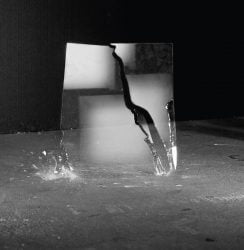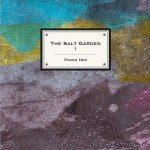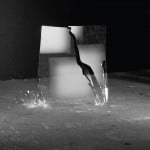FOVEA HEX – THE SALT GARDEN I
Slowly but undeniably, Fovea Hex receives the recognition they deserve. One of contemporary music’s most fascinating ‘hidden secrets’ is slowly revealed to a greater public.
Being the first non-Steven-Wilson release on Steven Wilson‘s label Headphone Dust will probably help find a new audience, but Fovea Hex also stays true to their original home, Janet Records who co-release the album.
The music of Fovea Hex is unique because their work is unclassifiable. Firmly rooted in English/Irish traditional music, but nothing like ‘folk’ music, and not exactly ‘pop’ music either. Experimental music fundamentalists will probably back away at first, because the music sounds so ‘natural’ and ‘organic’, but in fact what Fovea Hex does is more experimental than most. They continue to redefine borders and create their very own musical landscape.
Core members of Fovea Hex are Clodagh Simonds, Laura Sheeran and Michael Begg. For each project, there’s quite a list of contributors: artists like Colin Potter (Nurse With Wound), Andrew McKenzie (Hafler Trio), Michael Begg, Brian Eno, Roger Doyle, William Basinski (and more).
There’s the unique combination of the poetic lyrics, sung with enchanting angelic voices, and the musical arrangements that can sometimes be stretched to surprising extremes, especially in the remixes that are usually added as a bonus with every album’s first edition.
Words fail to describe properly… if you want to have a ‘first impression’ you can probably best check out this mix I created back in 2008 from their first album set Neither Speak Nor Remain Silent (including parts of the Hafler Trio remixes that are now no longer available).
Or simply check The Salt Garden I, their latest release.
True to their original form, this is the first of three EP’s that together will complete the full album.
This Part I presents three songs (or maybe we should call them recitals?) and an instrumental piece, Solace, dedicated to Oliver Sacks (including ‘cathedral interims’ by Brian Eno).
The traditional bonus (now unavailable, I’m afraid) is a remix version of Solace by Steven Wilson, who stretches the length to over three times the original and altering the timbre of the piece considerably, while at the same time staying close to the original composition.
That is a somewhat different approach from the way Hafler Trio, Colin Potter, William Basinski and Michael Begg remixed songs from the previous albums: extremely minimal ambient with a lot of silence in-between, where it could be hard to trace back to the originals.
The beauty of Fovea Hex may be unknown to many but it’s not thát big a secret: the bonus edition was sold out on pre-release. So you’ll have to do without the bonus now…
But not to worry: the 10″ vinyl version, or CD version, or digital version, are definitely worth your full attention!
And better luck next time, as far as bonuses are concerned!


MICHAEL BEGG / HUMAN GREED – LET THE COLD STOVE SING
One of the main (musical) contributors of Fovea Hex, Michael Begg, also releases music under his own name as well as Human Greed (and sometimes both at the same time).
Let the Cold Stove Sing is the follow-up to last year’s Hivernant. It is a collection of works conceived for theatre, galleries and installation, which means there are quite some different kinds of soundscapes collected here. Some (rather dark and ominous) atmospheric electronic sets, interspersed with almost hesistant sounding piano pieces, but also environmental sound collages (Paris is Closing), symphonic themes (Cunny for Thine Fountain Penne), spooky string sections and frightening outburst of inescapable sound (Studies in Space and Density).
It’s a weird and fantastic world unfolding before your (inner) eye.
Compared to the refinement of the Fovea Hex release, the music on this album has a rougher edge to it, a much different overall sound too.
(The pieces..) ‘are informed by the great divorce of music and context occasioned by the birth of recording, and by the 20 year fermata occurring after the invention of recording and before the discovery of the means of affecting playback. This was, by definition, the period where we began to conceive of the need to listen repeatedly, in the way an archaeologist brushes repeatedly at the desert, for clues, details, and, possibly, reason.’
J. PETER SCHWALM – THE BEAUTY OF DISASTER
It’s the Brian Eno-connection that loosely links this album to the others mentioned above. J.Peter Schwalm is a German composer probably best known for his collaboration with Eno on Music for Onmyi-Ji (2000) and Drawn from Life (2001). But to leave it at that would not do justice to his art and his other albums Musikain (2006) and Wagner Transformed (2013), as well as the many facets of his other works: the Slop Shop electro-jazz, the soundtrack for Nicholas Winding Refn’s Fear X (2003), his reworkings of Kraftwerk’s music for the Icebreaker Ensemble in Kraftwerk Uncovered: A Future Past, his (live-)remixing (for example this Ben Frost set and this fascinatingly loud Heroes remix).
And also to his latest album: The Beauty of Disaster.
There are some impressive contributors (though no Eno this time): most notably Eivind Aarset on guitars and Neil Catchpole on violas. J. Peter Schwalm himself is contributing guitars, pianos, all kinds of electronic devices, sound modules and mixing desks.
As on all his work, Schwalm links electronic music to orchestral, and ignores borders between ‘classical’ and ‘popular’ music. His work is hard to define, it contains elements of all genres, combined – it is modern classical jazz music with rock influences and ambient atmospherics.
Some of the works are based on ‘live remixing’ principles, while other are rooted in multi-track composing – “Emotional depth is more important than technical detail”.
It is powerful, highly suggestive and sometimes rather abstract music, inspired by contemporary images:
“I had been deeply impressed by satellite images of the catastrophic oil spill in the Gulf of Mexico while composing new pieces for this album. These surprising photos, which so reminded me of paintings, seemed to embody the very same deep duality between the dark melancholia they depicted and a continuous, meshed sense of hope, an embedded ray of light, as did the compositions I was working on.”
J. PETER SCHWALM – ZIRKELTRILOGIE




